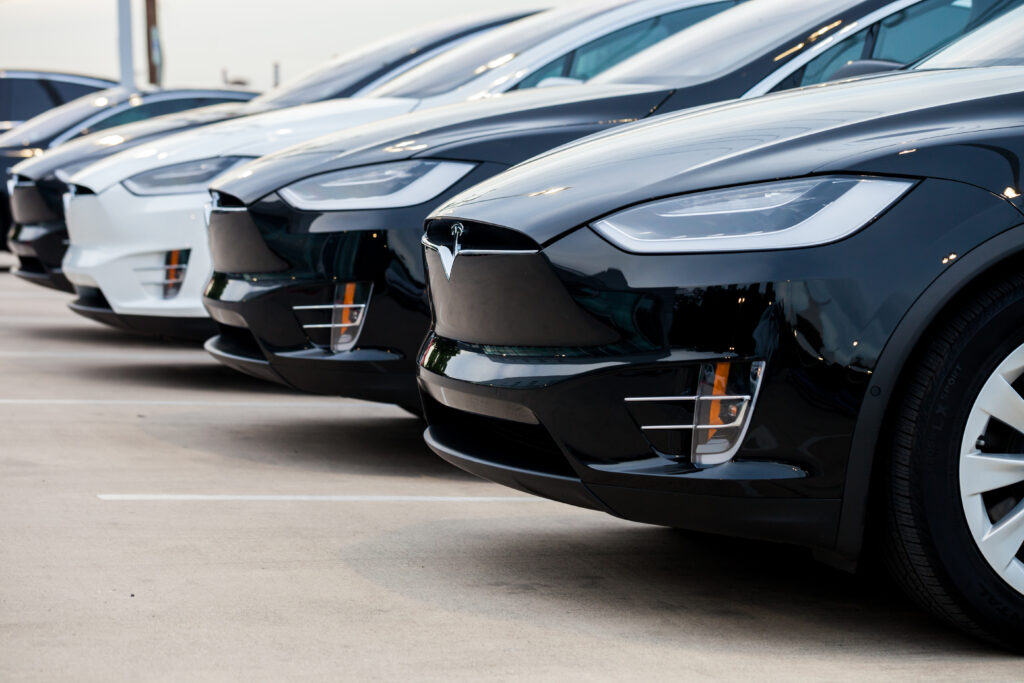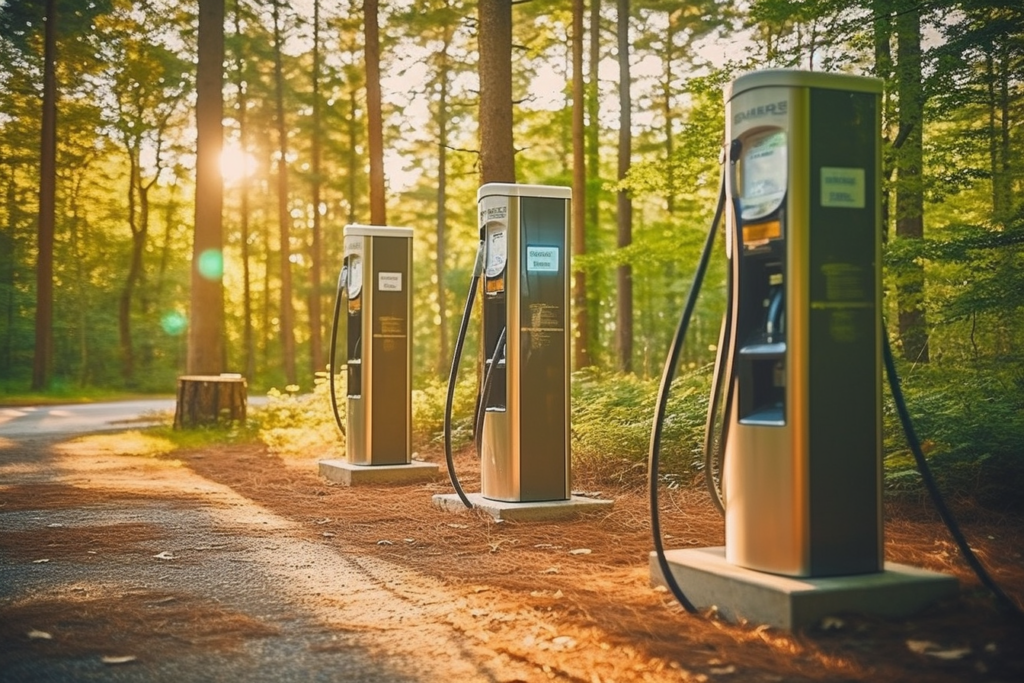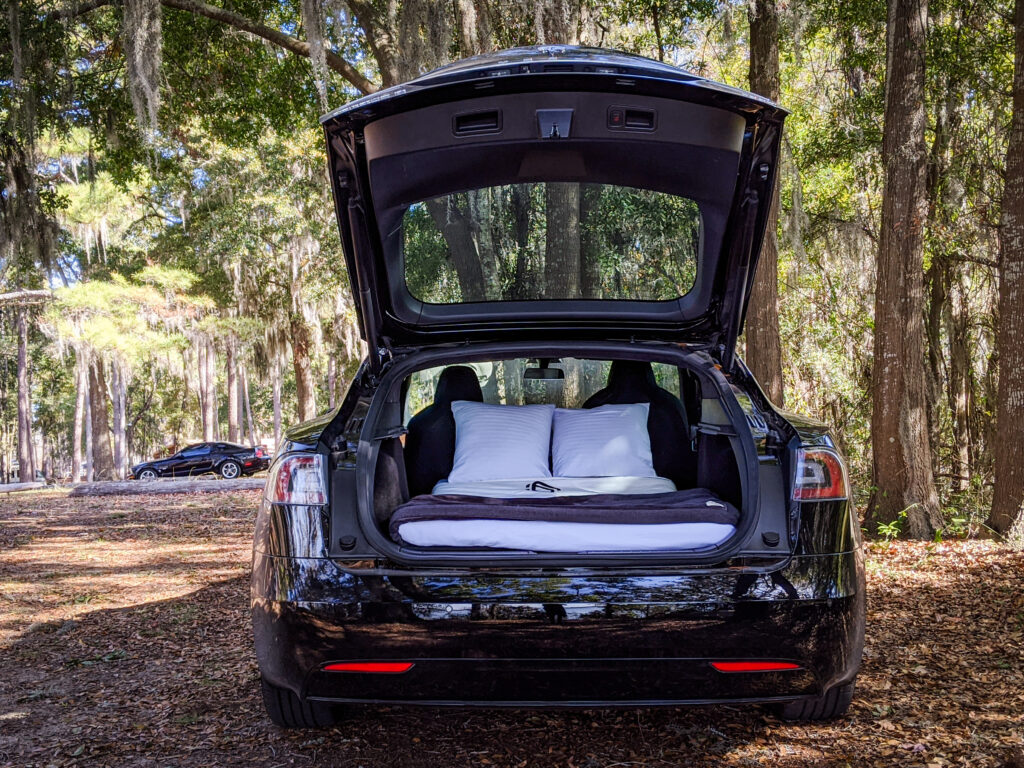- The electric car revolution
- A quick spin through how electric vehicles work
- Choosing the right electric car for your travel needs
- Traveling in an EV: the good, the bad, and the dead battery
- Planning your EV road trip
- Prepping your EV for the great outdoors
- Are there certain settings I can use to turn my EV into a ‘car camper’?
As an eco-conscious driver, you yearn for a car that safely takes you on your next adventure—and aligns with your values.
Electric vehicles (aka EVs) are becoming an increasingly accessible way to hit the road without compromising your commitment to the environment. But gaps in EV range and charging infrastructure can feel like an obstacle to reaching “leave no trace” nirvana.
This leaves travel and nature enthusiasts asking: Can EVs actually go the distance?
Read on for what factors to keep in mind if you’re considering buying an EV to satisfy your wanderlust. If you already own an EV and want to start planning your next adventure, feel free to skip ahead here.
Learn more about how Lemonade Car rewards EV drivers for their environment friendly driving choices here.
The electric car revolution

In the past decade, the EV landscape has transformed remarkably, igniting a revolution in the auto industry.
The early history of EVs can be traced back to the mid-19th century. But it wasn’t until the 21st century that they started gaining significant traction among the American public. This resurgence came mainly from concerns over climate change, rising fuel prices, and advances in battery technology.
Fast forward to today, and electric cars are soaring in popularity. As of 2022, there were over 1.7 million electric vehicles on the road in the US. That’s a surge of 250% over five years. And the Edison Electric Institute projected that figure will reach 26.4 million by 2030.
The electric car revolution is already here, and it’s reshaping our highways and cities—along with how we plan our trips.
A quick spin through how electric vehicles work
There are some key components of an electric car that differ from what your traditional vehicle uses to drive and operate.
The main distinction is that electric cars have a large battery that fully runs on electricity to power the motor instead of traditional gasoline. On average, EVs can run for 250 miles per battery charge.
To keep an electric car going, you’ll need access to a charge port to recharge the battery using an external power source. EV drivers can fully charge their cars at any convenient charging station—like at a shopping mall, or a parking lot. Depending on the type of charger available, and how low your battery level is, the charging time could take anywhere from 15 minutes to several hours.
In a pinch, keeping a portable charger on hand will give you the freedom to connect your EV to a standard electrical outlet. Or if you’re a driver who wants to level-up their charging game, at-home charging ports are a convenient (and not crazily expensive) way to charge your battery overnight from the comfort and safety of your home.
Choosing the right electric car for your travel needs
When it comes to selecting the perfect EV for your adventures, you’ll need to consider several factors to align with your specific travel needs and lifestyle. It goes much deeper than simply picking the model with the longest range.
Start by asking yourself a few questions about the types of trips you typically take:
- Are you more a fan of the occasional longer cross-country road trip, or more frequent shorter weekend getaways that are closer to home?
- Will the trips include a lot of uphill—or up mountain—driving?
- Do you opt for well kept pavement, or prefer the thrill of off-roading?
The frequency, distance, and difficulty of your trips will largely determine what you’ll require from your EV.
If you’re more inclined towards lengthy journeys, for example, a more compact EV with a substantial range would be a priority. If your trips are often shorter, more local, and on rugged terrain you might be able to compromise on range, but prioritize a heavier duty vehicle with more comfort and cargo space for camping gear—like a top mileage electric SUV.
When you’re shopping around for an EV, don’t be afraid to ask the dealership for some specifics:
- What’s the vehicle’s range, and how does the range change under different driving conditions (like uphill driving)?
- What charging options does the car support, and what is the typical charging time?
- How much interior space does the vehicle have?
- What are the recommended tires for long-distance travel and varied terrain for this vehicle?
- What’s the vehicle’s towing capacity? (if you’re planning to haul a camper or trailer)
- What kind of tire pressure monitoring systems (TPMS) does the vehicle have?
- What warranties or guarantees come with the vehicle’s battery?
And if you’re considering buying a used EV, there are some additional considerations and questions to factor into the process.
Want to see how different EV models hold up during road trips and camping trips? Check out YouTube channels that put the specs into practice—like Bjørn Nyland who does overnight sleep tests in different EV models (sometimes in below freezing temperatures), and Out of Spec Motoring who assesses their experiences taking long road trips in different EV models.
Traveling in an EV: the good, the bad, and the dead battery

There are several pros and cons of electric cars to consider for any lifestyle, but especially if you plan to use your EV as a four-wheeled travel buddy.
Here’s the TL;DR
| Pros | Cons |
|---|---|
| Lower carbon emissions per adventure | Limited range |
| Cost-effective (fuel costs and maintenance) | Range dependent on weather conditions and terrain |
| Growing network of charging stations | Not enough charging infrastructure, depending on where you’re going |
Pros
According to a 2015 study by the Natural Resources Defense Council, plug-in electric vehicles (PEVs) have 54% lower lifetime carbon pollution compared to conventional cars, helping reduce your carbon footprint. And every year EVs become more mileage efficient, potentially making that reduction even larger.
EV owners tend to spend 60% less to fuel their vehicle than people who drive a conventional car, according to a 2020 Consumer Reports study, meaning you could save money on fuel costs over the course of your trip. Keep in mind that prices will vary depending on whether you’re charging up at home, or at a public charging station.
The number of charging infrastructure for EVs has grown consistently since 2011, making long-distance travel in an EV more feasible. And in 2023, the Biden-Harris administration announced a $7.5 billion investment in charging infrastructure, including a national network of 500,000 EV chargers by 2030.
Cons
Certain newer EV models—including the 2023 Lucid Air, Tesla Model S, and Hyundai Ioniq 6 models—already offer ranges similar to a conventional gas-powered car. To put things in perspective, as of 2021 the average gas-powered car range in the US was 413 miles.
But the average range of an EV—which is about 250 miles—still might limit how far you can travel between charges, potentially adding more time (and headache) to your trip to recharge.
Charging infrastructure, while rapidly improving, still has gaps, which can make planning longer trips or off-the-beaten-path adventures more challenging. As of 2022, the US still had three times as many gas stations compared to EV charging stations.
Many EV drivers have experienced the nightmare of pulling up with a low battery to a charging station in the middle of nowhere—only to find it’s out of order, or has a long waiting line.
What’s more, driving in extreme temperatures, or on rugged or uphill terrain, can significantly reduce an EV’s range. Some EVs can lose up to 35% of their range in freezing temperatures. Using the air conditioning during a drive on a hot summer (or heating during the winter) can also affect your EV’s range.
Planning your EV road trip
Until the day comes that EV charging stations are as available and speedy as fueling up at conventional gas stations, you’ll need to do a little more research and planning for your longer EV travels.
Identify your destination, route, and charging stops
Start by deciding where you want to go and the sights you want to see along the way. Keep in mind the range of your EV.
Map out charging stations along your route using mobile apps like PlugShare, Electrify America, or Charge Hub (or download them all, to be safe), which you can connect to your vehicle’s navigation system.
It’s ideal to plan your charging stops in places where you can also eat, sightsee, or relax while your car charges, since it can take some time—especially if you’re relying on Level 2 chargers. It might not be too pleasant to spend two hours in a 7-11 parking lot next to a highway.
Book accommodations with charging facilities
If you plan to stay somewhere overnight during your trip, look for accommodations or camping sites with charging facilities. Some hotels now offer Level 2 chargers, allowing you to start each day with a fully charged battery.
Certain hotel chains—including Holiday Inn and Hilton—are leading the way in offering EV charging for their guests. There are also several mobile apps that help EV drivers find charging ports at or near their hotel, like the EV hotel app.
Check the weather
Both extreme cold and hot temperatures can impact your EV’s range. Factor in extra charging time, especially if you’re traveling during the winter.
Adventuring down South during the dog days of summer? Pre-cool your EV while it’s plugged in, instead of blasting the air conditioning once you’re already driving off, so the energy being used to cool your car is coming from the grid—and not your battery.
Prepare for the worst, hope for the best
Even the best-laid plans can change, so stay flexible.
- You might want to follow a scenic detour
- Unexpected weather could throw a wrench in your gears
- Charging stations may be unexpectedly out of service
Be ready to adapt your plan as needed.
Prepping your EV for the great outdoors
Before you set off, make sure your EV is up-to-date on any routine maintenance—like checking the tire condition and pressure, ensuring the brakes are in good shape, and confirming that the car’s software is updated.
Pack all the road trip essentials—such as reusable or compostable trash bags, plenty of water, and proof of car insurance.
FuIly charge your EV, and pack some charging essentials, including:
- Portable EV charger to recharge your vehicle at campsites or at other locations that have accessible electrical outlets. Test it before you leave to ensure it’s working correctly.
- Charging adapters. Different charging stations might have different plug types.
- Heavy-duty outdoor-rated extension cord that’s suitable for EV charging. This can be useful if your charging cable can’t reach an outlet at a campsite.
- Battery warmer. If you’re charging up in cold weather, it’s worth considering a battery warmer to keep your EV’s battery pack at the optimum temperature. (But most modern EVs now have a built-in battery pack cooling and heating system to help keep the battery at the right temperature for efficient charging.)
When it comes to loading up your EV for a trip—whether you’re bringing three Samsonite suitcases and a mountain of climbing gear, or a single Osprey daypack—be mindful of how much weight you’re adding to the vehicle, which can impact your range.
Are there certain settings I can use to turn my EV into a ‘car camper’?

For the EV driver who wants to camp literally inside of their car, there are ways you can sleep tight, charge your devices throughout the night—and hopefully not let the outside bugs bite.
For example, certain Tesla models offer a ‘Camp Mode’ setting that maintains the cabin temperature, allows you to power your vehicle’s USB and 12V outlets, and play media for hours. Just make sure your Tesla still has at least 20% charge.
Also, Hyundai’s Ioniq 5 offers a ‘Utility Mode’ that allows you to power electronic devices, listen to your favorite podcast, or read a book with the lights on, all without starting the vehicle.
Check your EV’s owner manual for what settings can help optimize your next camping trip.
Safe travels for the road ahead
Want to protect your four-wheeled travel buddy with car insurance that prioritizes your safety, your wallet, and the planet?
At Lemonade Car, we’re fueled by our love for the environment, and we go the extra mile for eco-conscious drivers. Here’s how:
- We reward low-mileage drivers with savings.
- We’re the first US insurance company to publicly forswear investment in fossil fuels.
- The Lemonade Giveback helps transform car insurance into a social (and environmental) good. When you buy a Lemonade Car policy, you’ll be eligible to select a cause you care about—including non-profits helping the environment.
Click below to get your quote started. It’s quick, easy, free—and dare we say, even kind of fun.
A few quick words, because we <3 our lawyers: This post is general in nature, and any statement in it doesn’t alter the terms, conditions, exclusions, or limitations of policies issued by Lemonade, which differ according to your state of residence. You’re encouraged to discuss your specific circumstances with your own professional advisors. The purpose of this post is merely to provide you with info and insights you can use to make such discussions more productive! Naturally, all comments by, or references to, third parties represent their own views, and Lemonade assumes no responsibility for them. Coverage and discounts may not be available in all states.





